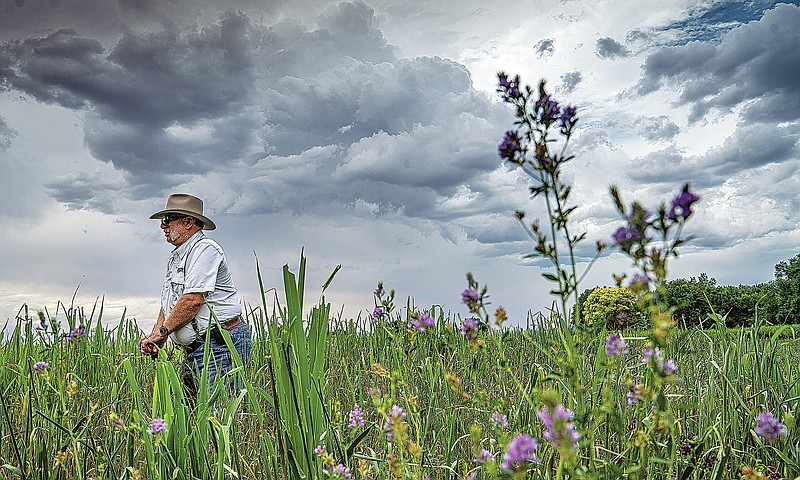SANTA FE, N.M. -- Four months ago, Paul Skrak was among the New Mexico farmers who braced themselves for a bleak summer when acute drought conditions delayed the growing season by 30 days.
But the past few weeks have brought rainfall that's defying earlier doubts of a strong monsoon, which has eluded the region for several years.
Water managers welcome the downpours, saying they are boosting river flows and offering a much-needed break, however brief, in the state's stubborn drought.
For farmers, this abrupt reversal of meteorological fortune has generated too much rain, too fast, creating a different set of problems.
"It has damaged the chile, and damages the grass hay, and just plain kills the alfalfa," said Skrak, owner of the 55-acre Hidalgo Farms near Santa Fe.
Skrak said the rains have made the fields so muddy that he can't drive a tractor on them to harvest the grass hay and alfalfa.
Weeds also proliferate in wet weather, demanding more removal. They block the sunlight, stifling the peppers, especially the habaneros, Skrak said.
"That's the problem we're having right now: The habaneros are not growing very well," he said.
Skrak expects he will have only two cuts -- or batches -- of hay and alfalfa this season, less than the three he cultivates in a normal season.
While the spate of rainstorms is resulting in less profitable yields for growers, they are making somewhat of a dent in the water shortage -- or at least preventing it from getting worse, officials say.
"The rain that we did get in the river from all the various storms has helped tremendously," said Mike Hamman, chief executive and chief engineer for the Middle Rio Grande Conservancy District.
The district has not had to tap the 12,000 acre-feet of irrigation water it recently received from the U.S. Bureau of Reclamation, Hamman said. The water is stored in the Abiquiu Reservoir and will be released when needed.
An acre-foot is about 326,000 gallons, enough to supply an average U.S. household for a year.
Farmers are getting by with less surface water for irrigation, partly because of the rain and also because they are growing less, Hamman said.
Three months ago, it was questionable whether there would be any water for growers beyond early July, and now supply could be stretched to mid-August, depending on whether the rains continue, he said.
The storms also have filled the Rio Grande's dry stretches with water needed to sustain endangered species, such as the silvery minnow, Hamman said.
And they have enabled the state to funnel more Rio Grande water to Elephant Butte to supply Texas and meet the requirements of a multistate water-sharing agreement, Hamman said.
New Mexico came into this year owing Texas 96,000 acre-feet, he said. He wants the district to do its part to keep the debt from worsening.
The debt prevents New Mexico from drawing and storing Rio Grande water, leading to reservoirs being at their lowest levels in at least 20 years.
Three weeks or even a full season of rain won't replenish the severely depleted reservoirs, Hamman said, noting it could take years.
One downside to the storms is they caused flooding in Valencia and Eddy counties, breaching 20 ditches and clogging canals with silt.
"We're just now recovering from that," Hamman said.
Northern New Mexico is about to enter the wettest period it has had yet this year, said Jennifer Shoemake, a National Weather Service meteorologist in Albuquerque. The trajectory means farmers in the Middle Rio Grande Valley could receive some unwanted torrential rain.
"I know a lot of people want rain, but too much of a good thing is a bad thing," Shoemake said.
Historically, storms during the monsoon season that runs from mid-June through September drop an average of about 5.5 inches in the Santa Fe area and 4.5 inches in Albuquerque, she said.
So far, the rains have amplified river flows that the Buckman Direct Diversion relies on to supply water to the Santa Fe area, said Jesse Roach, the city's Water Division director.
Water officials recently contemplated shutting down the treatment plant temporarily if the flows in the Rio Grande dropped too much.
But the rainfall has boosted the river, and if it continues at a similar rate into September, it should eliminate any threat of a shutdown, Roach said.
About 80% of the water needed to meet the city's demand has come from the river, and the rest comes from groundwater wells, Roach said. The more rainfall, the less the city has to rely on groundwater.
"It's really helping a lot," Roach said.



